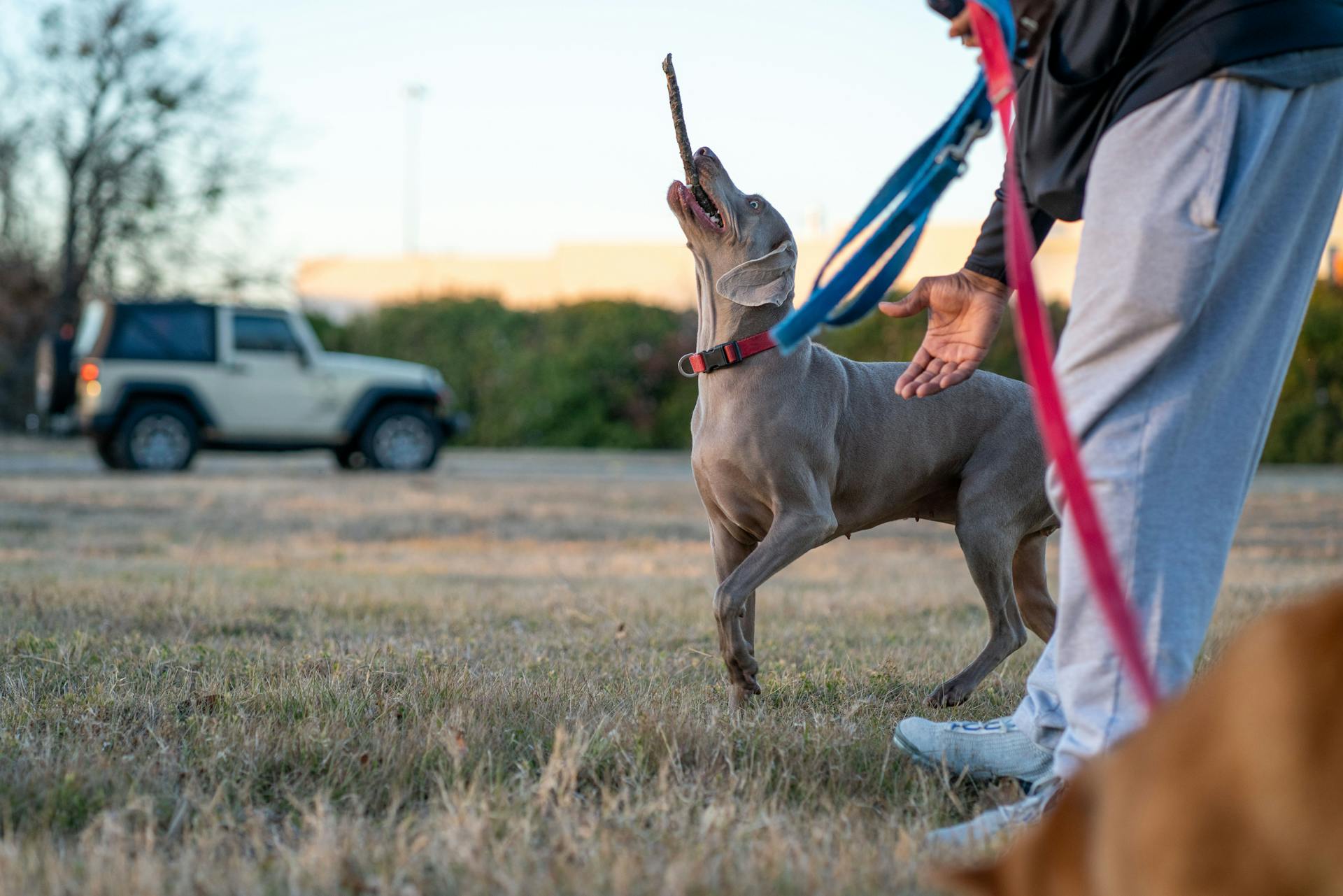
Starting a dog training journey can be overwhelming, especially for beginners. It's easy to get caught up in the idea that there's a magic solution that will fix all your dog's behavioral issues overnight.
But the truth is, nothing in life is free, and dog training is no exception. You can't expect your dog to learn without putting in the time and effort to teach them.
The first step in dog training is to establish a routine and set clear boundaries. This means creating a schedule for feeding, exercise, and playtime, as well as setting rules for behavior and consequences for misbehavior.
What is Free?
Giving your dog resources without earning them can undermine the effectiveness of "Nothing in Life is Free" training. You may be mindlessly petting your dog or feeding them without making them perform a command.
Stop giving your dog your attention for no reason. Your attention is a valuable resource to your dog, and giving it away can create a sense of entitlement.
Curious to learn more? Check out: Dog Training without Treats
Be aware of your dog's behavior and adjust your actions accordingly. For example, if your dog is always jumping up to get your attention, make them sit before interacting with them.
Here are some examples of what is free in a dog's life:
- Food and treats without performing a command
- Attention and affection without earning it
- A walk without sitting first
- Playing fetch without shaking hands
In order to make "Nothing in Life is Free" training work, you need to make your dog earn these resources by performing a command first.
Nothing in Life Is Free
The NILIF program is a game-changer for dog owners. It's all about teaching your dog that nothing in life is free, and that they need to earn everything they want from you.
By setting small tasks for your dog before they receive something from you, you're showing them that you're the leader. This approach has many benefits, including keeping your dog's mind working throughout the day without a formal training session.
To use the NILIF program effectively, try giving your dog a sit command before letting them through the door. They must stay in the sit position until released with their release command. This will strengthen their sit, stay, and release word.
A different take: Nilif Dog Training
Here are some examples of how to use the NILIF program:
- Before feeding your dog, have them perform a few basic obedience commands. Hold their position while the bowl is placed down, and teach them an "ok" command that means they can eat.
- Before being invited onto the furniture, have your dog lay down until invited.
- When your dog jumps on you, tell them to sit instead of giving them attention.
Consistency is key when using the NILIF program, so make sure everyone in the house is using the same rules with the dog.
Here's a quick checklist to see if you're ready to start the NILIF program:
- Do you leave food down all day for your dog?
- Do you give in and play when they jump on you?
- Do you allow your dog to get away with undesired manners, like barking for attention?
- Does your dog run roughshod over you?
If you answered yes to most of these questions, it's time to get serious and start the NILIF program.
Applying the NILIF Program
To apply the NILIF program, you need to be consistent, firm, and fair. Consistency is key, as it helps your dog understand what is expected of them.
First, master some basic commands and tricks like "Sit", "Down", and "Stay" using positive reinforcement with praise and treats. Once your dog has these down, you can start using the NILIF program.
Here's how it works: before giving your dog routine things like food, a walk, or a pat on the head, they must first complete one of the commands you've trained them. For example, before feeding your dog, they must stay or lie down in one spot until you have filled the bowl.
To be successful, set your dog up for success by giving them tasks where they have a good chance of completing. Start with simple commands like "Look" and "Sit" and wait until they have mastered them before moving on to more complex commands like "Fetch" or "Come."
For your interest: 6 Week Dog Training Program
Firmness
Firmness is key when implementing the NILIF program. It's essential to be consistent and not reward your dog for half-hearted efforts.
If your dog only performs a command partially, don't reward him for it, no matter how cute he looks. This teaches him to put in the extra effort to do it properly.
My own Shiba Inu will sometimes only perform a half-down, but I give him a look and wait for him to do it correctly. This shows him that he won't get rewarded unless he does a good job.
Giving your dog a chance to succeed is crucial. Start with simple commands like Look and Sit, and only move on to more complex ones like Fetch and Come when he's mastered the basics.
Dogs have different temperaments and motivations, so it's essential to tailor your rewards to each individual dog. Some may prefer treats, while others may prefer pets or praise.
Related reading: Look at That Dog Training
When to Begin Dog Training
If you find yourself leaving food down all day for your dog, it's likely time to start dog training.
Leaving food out can create unhealthy habits in your dog, making it harder to establish good manners.
Giving in to your dog's demands, like playing when they jump on you, can also create problems.
Getting frustrated when your dog jumps on you just before dinner is a sign that you need to address this issue.
Allowing your dog to get away with undesired manners, like barking for attention, can be a sign that it's time to start training.
If your dog acts up when it's time to go for walks or runs roughshod over you, it's a clear indication that you need to establish some boundaries.
Here are some common signs that it's time to start dog training:
- Leaving food down all day
- Giving in to your dog's demands
- Getting frustrated with your dog's behavior
- Allowing undesired manners
- Difficulty going for walks
- Your dog running roughshod over you
Be Firm and Fair
Being firm and fair is key to implementing the NILIF program effectively. Consistency is crucial, and it's essential to establish clear rules and consequences.
Dogs are pack animals, and they thrive on structure and hierarchy. Using "Nothing In Life Is Free" kindly and consistently tells your dog that his role in the household is subordinate to yours.
To make this work, you need to be firm but fair in your training. If your dog does what you ask, he gets what he wants. He is in control to an extent, but you are determining the outcome and what has to be done in order for that to occur.
Here are some tips to help you achieve this balance:
- Set clear expectations and rules for your dog's behavior.
- Use positive reinforcement with praise and treats when your dog does what you ask.
- Be consistent in your rewards and consequences.
- Make sure all family members are on the same page and following the same rules.
By being firm and fair, you can establish a sense of order and structure in your home, which is essential for a happy and well-behaved dog.
How to Apply NILIF
Applying the NILIF dog training program requires consistency, firmness, and fairness. Consistency is key, as it helps your dog understand what behavior is expected of them.
To deny constant attention, simply walk away or ignore your dog when they're seeking it. This teaches them that attention must be earned, not demanded. Give attention only when your dog is calm and following house rules.
Additional reading: When to Start Dog Obedience Training
Encourage your dog to come to you and sit, and reward them with attention only if they remain calm and sit properly. If they start barking, jumping, or mouthing, walk away and try again later.
Teaching your dog to "stay" is a fundamental cue that helps with breaking bad habits. Maintain your composure and level of being in charge, as dogs that are confused about who's in control are more likely to act out.
Before using the "Nothing In Life Is Free" technique, make sure your dog has mastered basic commands like "sit", "down", and "stay." Use positive reinforcement with praise and treats when they do it right.
Here's a step-by-step guide to applying "Nothing In Life Is Free":
Remember to be patient and consistent, as it may take time for your dog to understand the new rules. If they snub you, ignore them or walk away, and try again later.
Why NILIF Makes Sense
Dogs are pack animals, and they naturally follow a social structure. This dominance hierarchy provides a structure that keeps order, cuts down conflict, and encourages cooperation among pack members.
In the wild, dogs ran in groups with a clear leader, and this trait has been carried over into their domesticated life. This means that your dog sees you and your family as part of its pack, and it looks to you for leadership and guidance.
To establish yourself as the leader of the pack, it's essential to use the NILIF (Nothing In Life Is Free) approach. This means that your dog must earn its place in the household by following rules and commands.
Children can also play a role in the dominance hierarchy, but it's essential to teach them how to use NILIF with the family dog. Children eight years old and up can start using NILIF, but they should do so under the watchful eye of an adult.
You might enjoy: Humane Hierarchy Dog Training

Here's a quick rundown of the NILIF approach:
- Deny your dog constant attention unless it's earned.
- Encourage your dog to come to you and sit to earn attention.
- Teach your dog to "stay" as a basic cue.
- Maintain your composure and level of being in charge.
By following these steps, you can establish yourself as the leader of the pack and help your dog understand its place in the household. This approach may take some time and effort, but it's a safe and non-confrontational way to turn the tables and make your dog more confident and secure.
Sources
- https://deafdogsrock.com/does-your-dog-need-nothing-in-life-is-free-training
- https://shibashake.com/dog/nothing-in-life-is-free-dog-training/
- https://www.dogmatters.com/nothing-in-life-is-free
- https://www.dogingtonpost.com/nilif-dog-training-how-it-works/
- https://dogtime.com/dog-health/general/684-basic-obedience-tips-aspca
Featured Images: pexels.com


